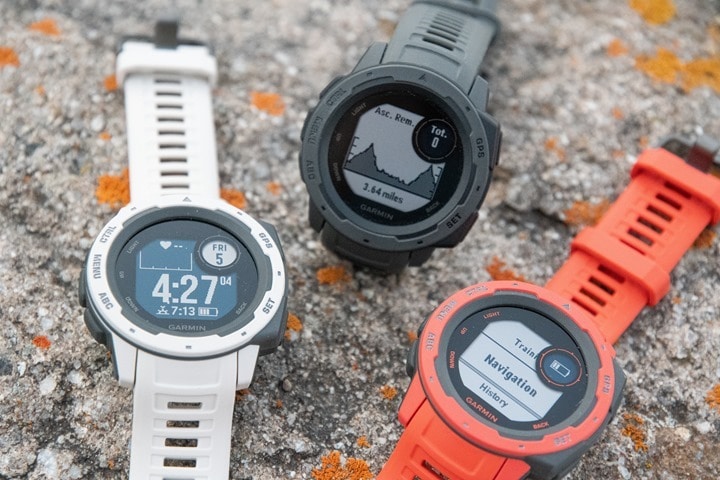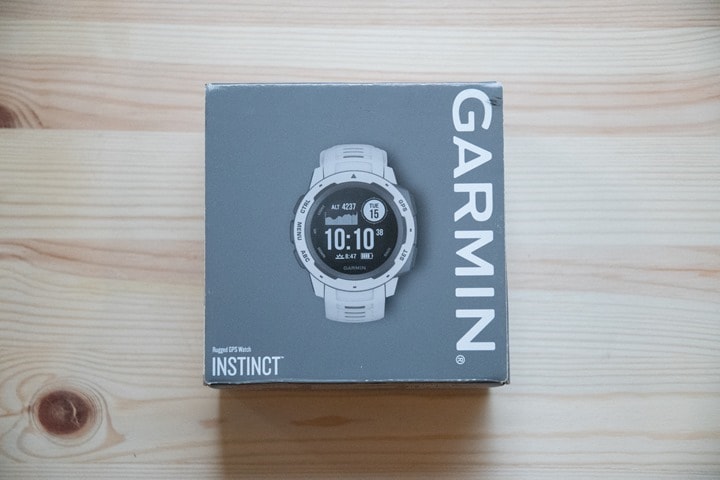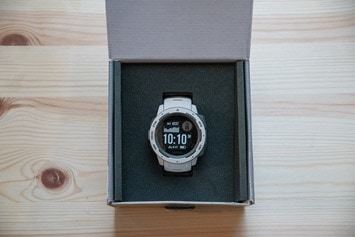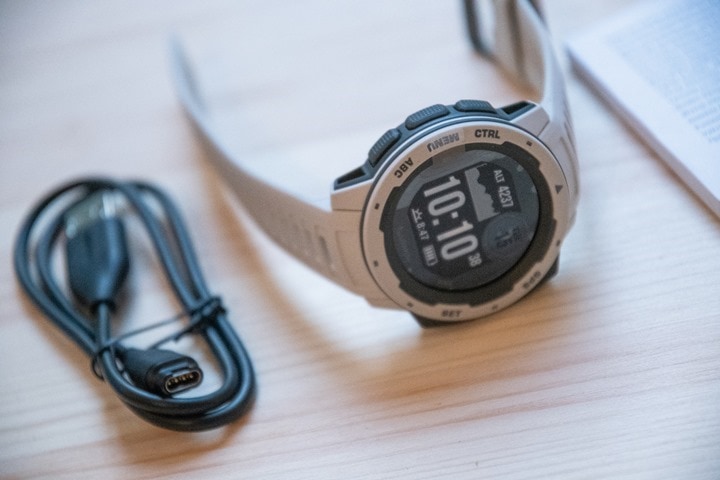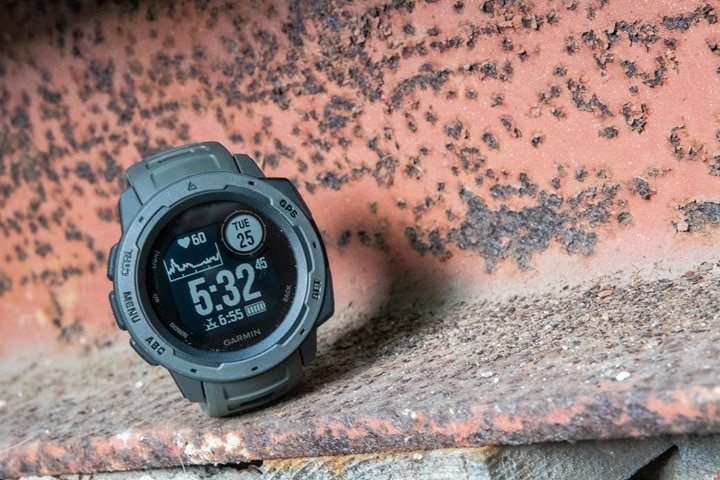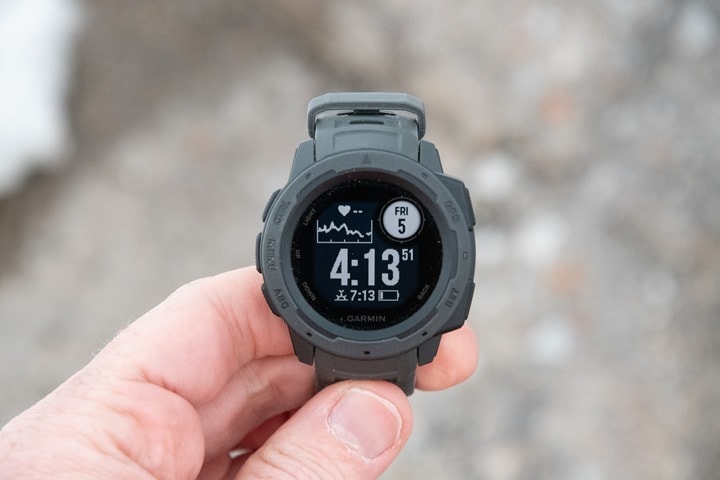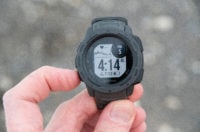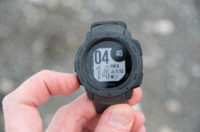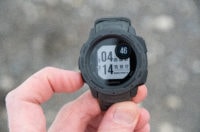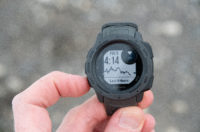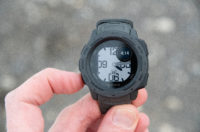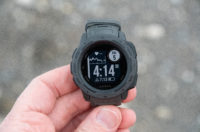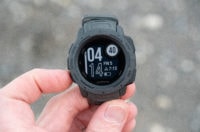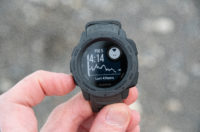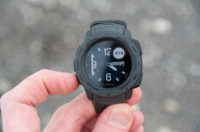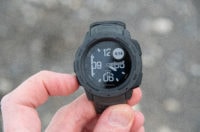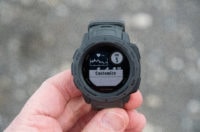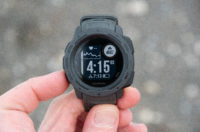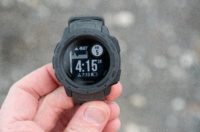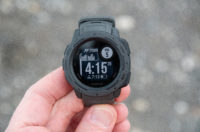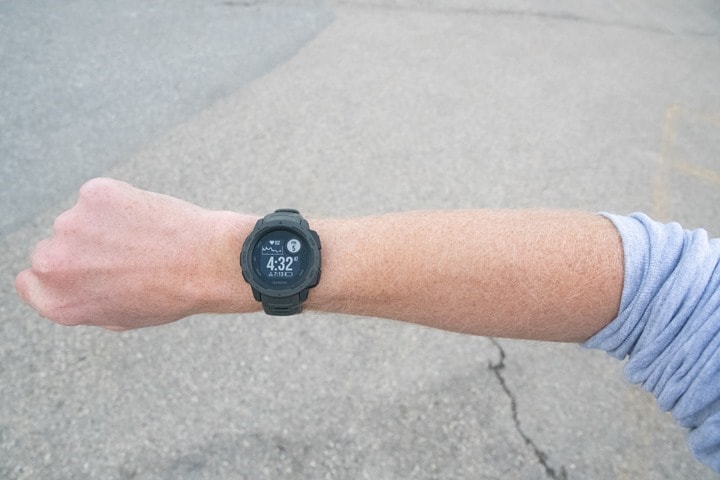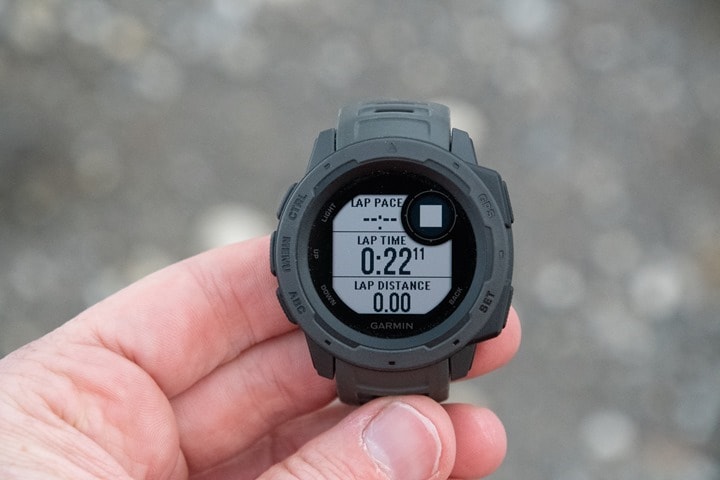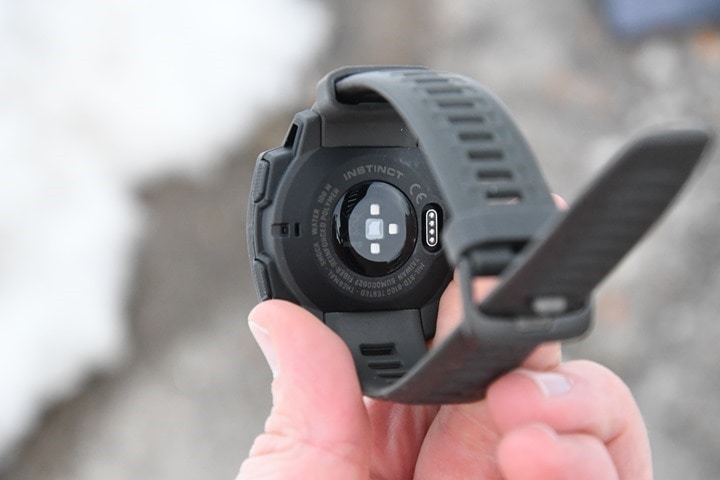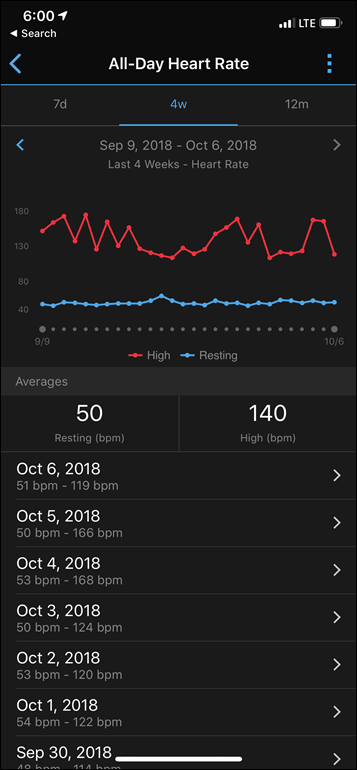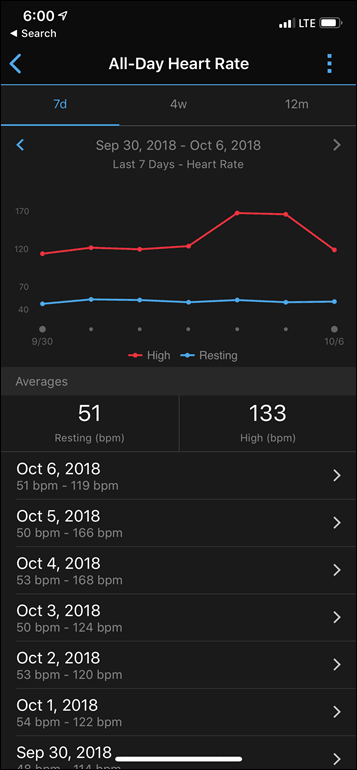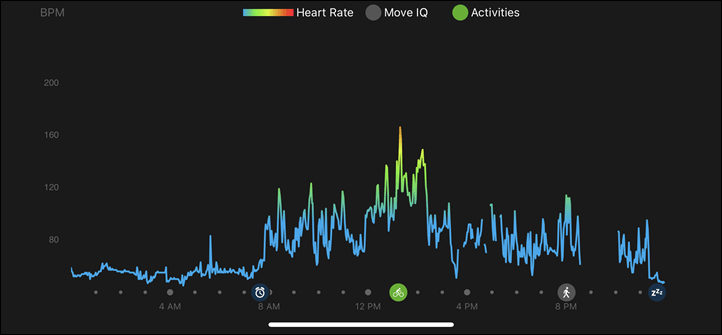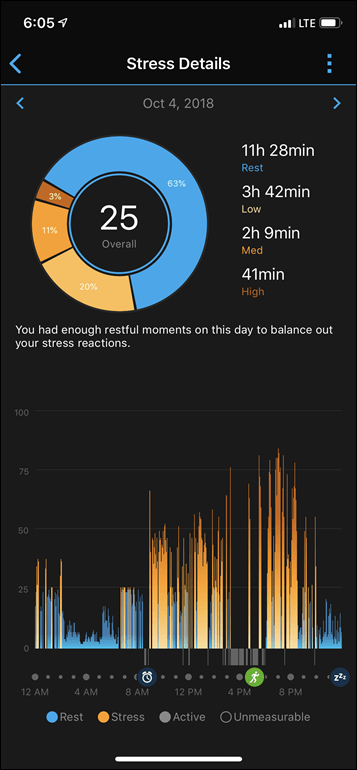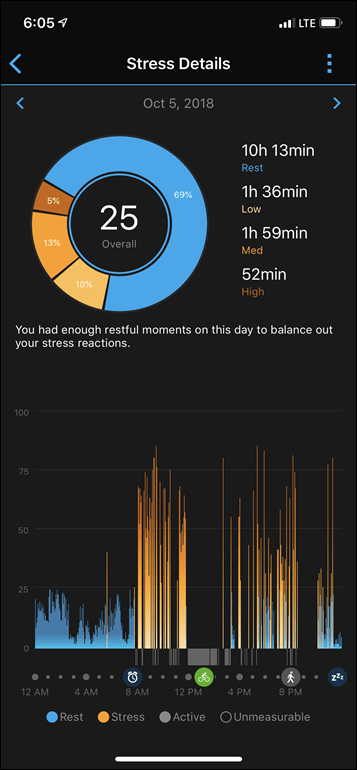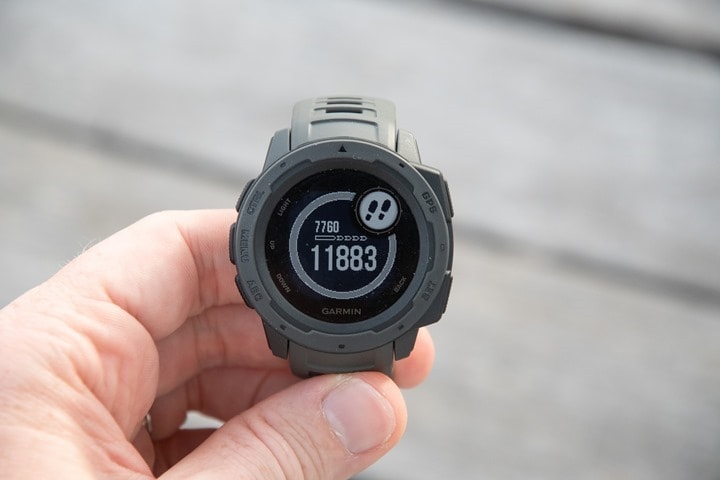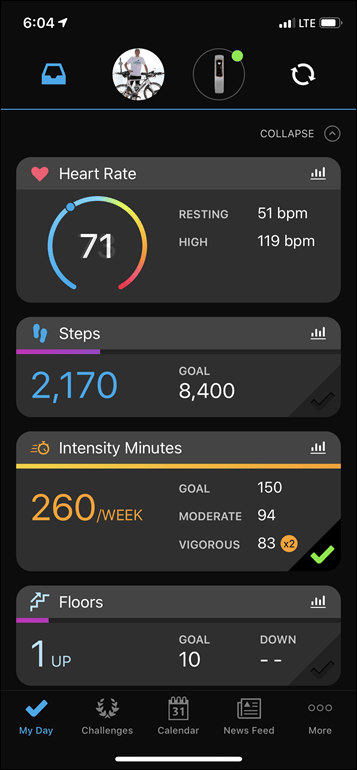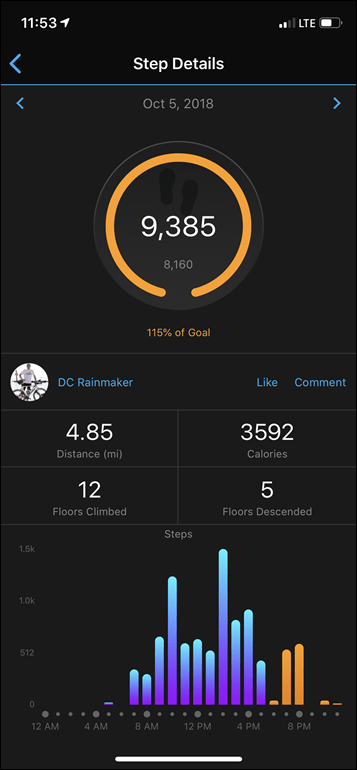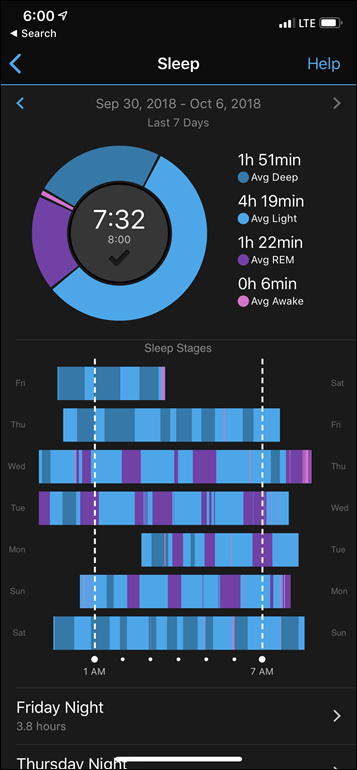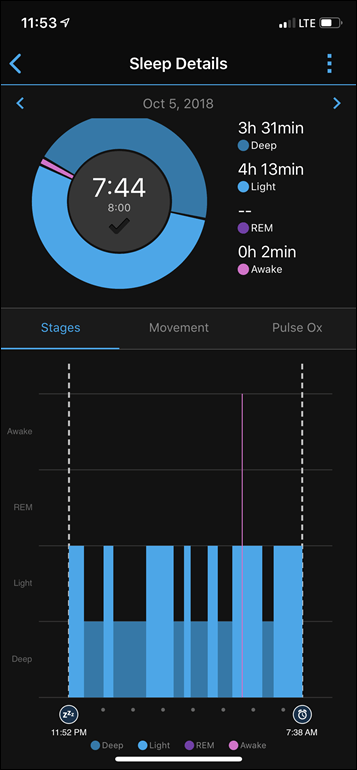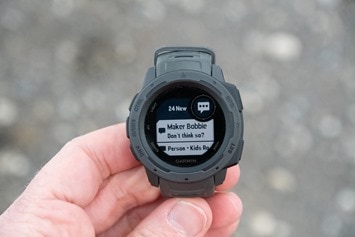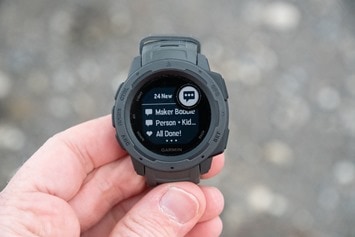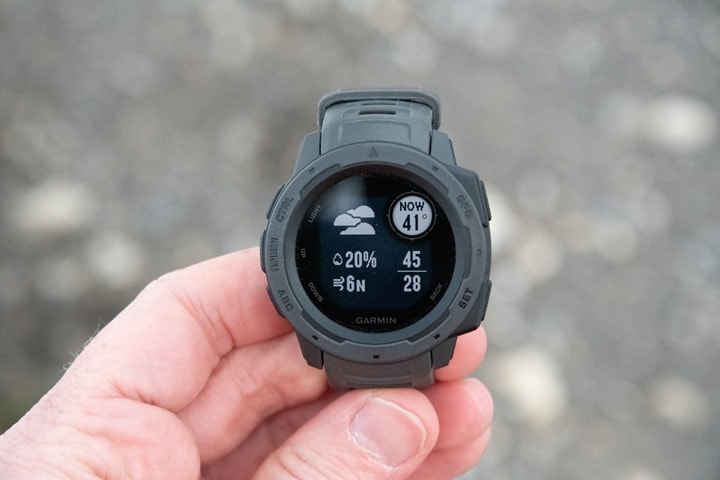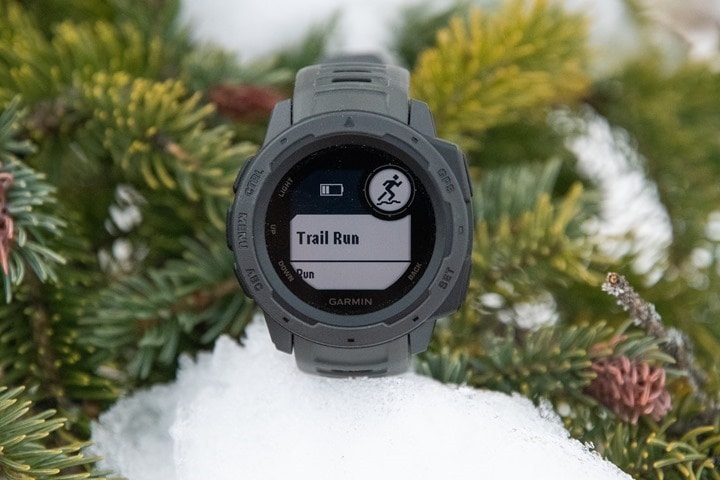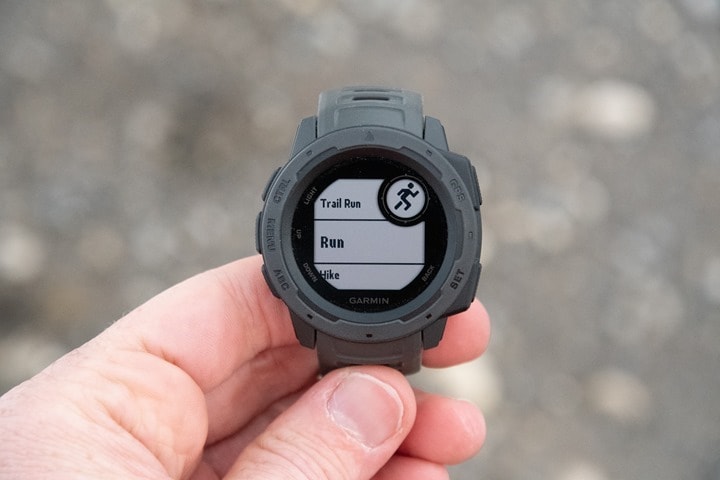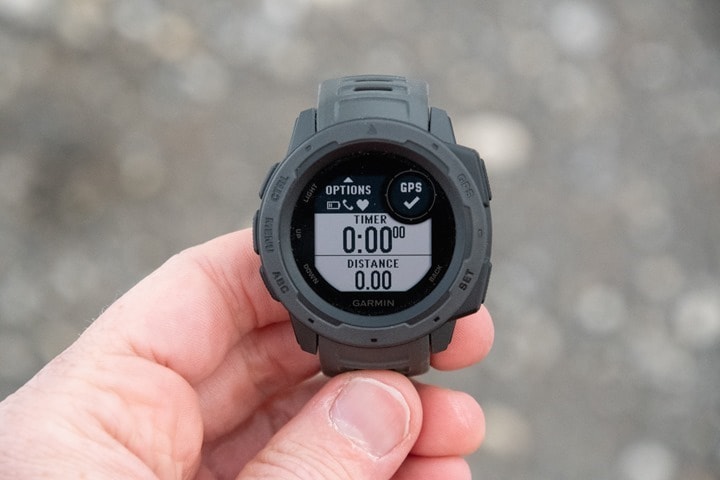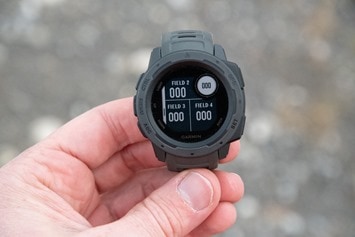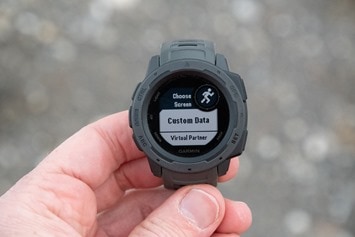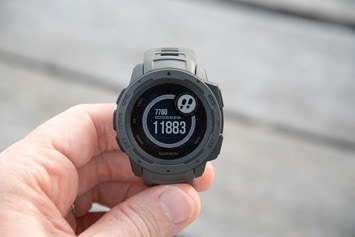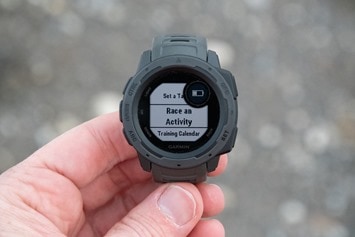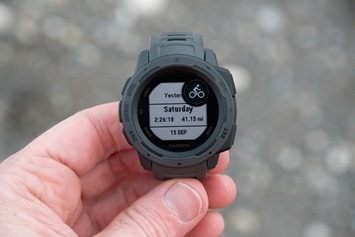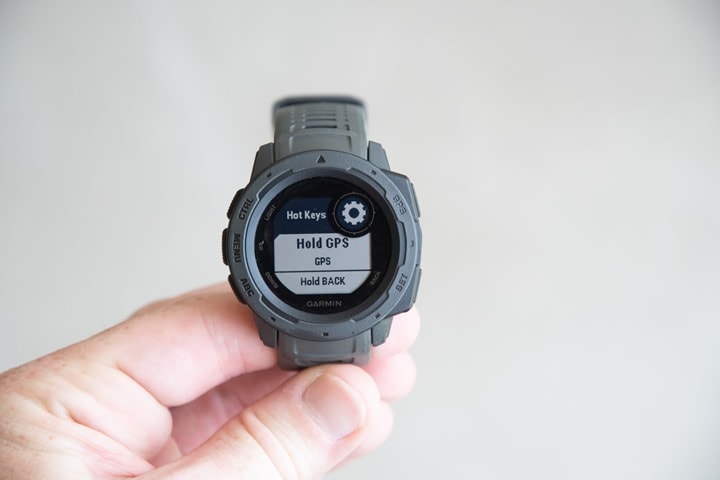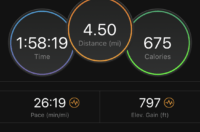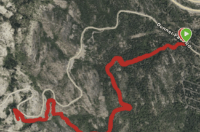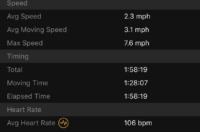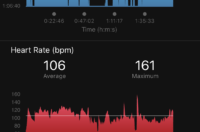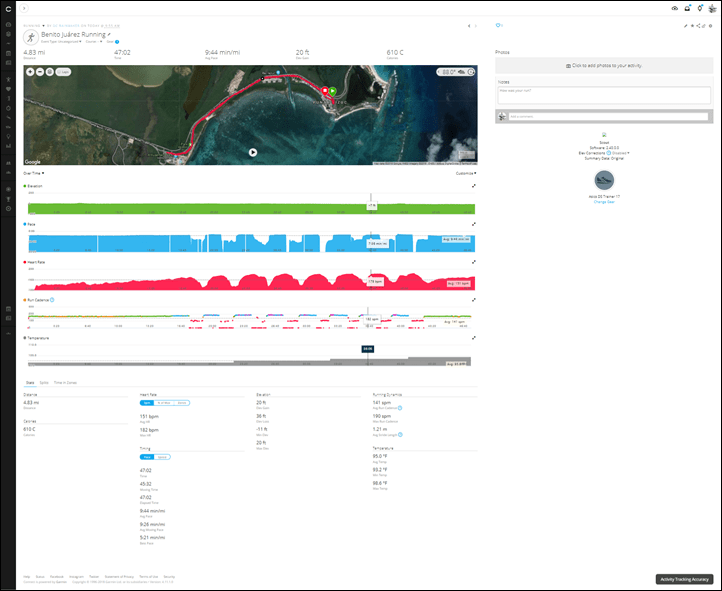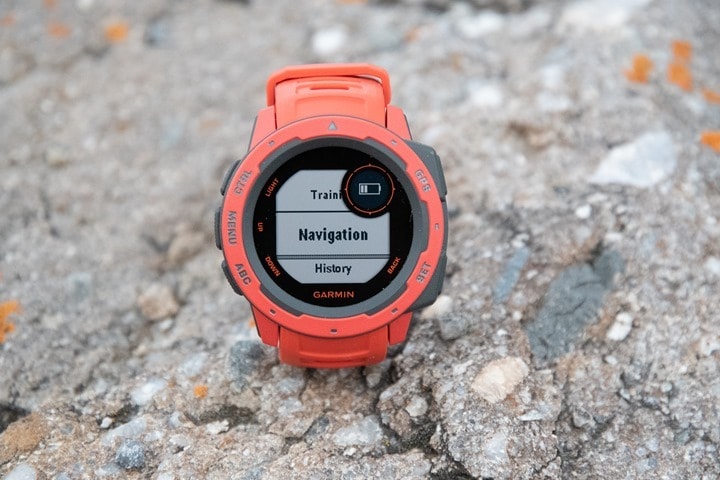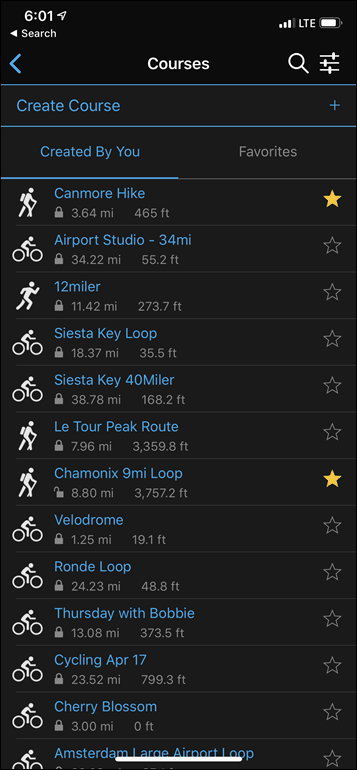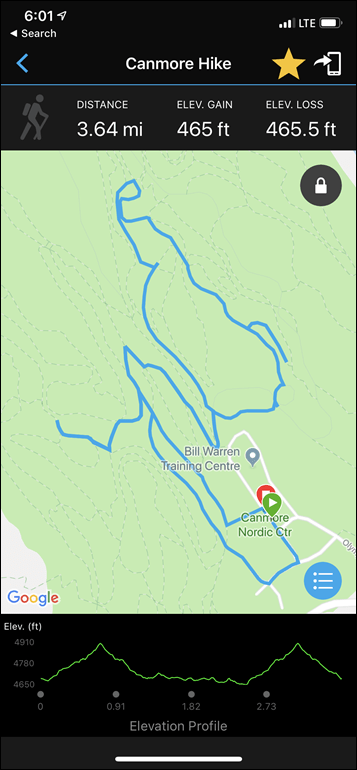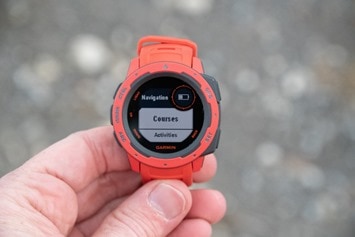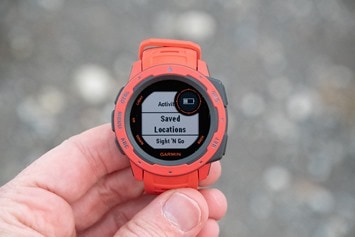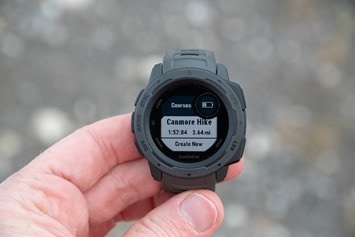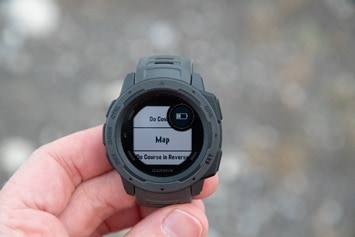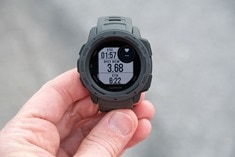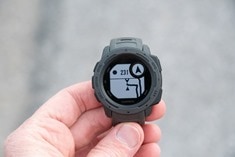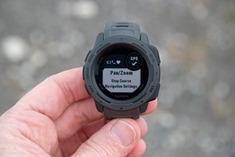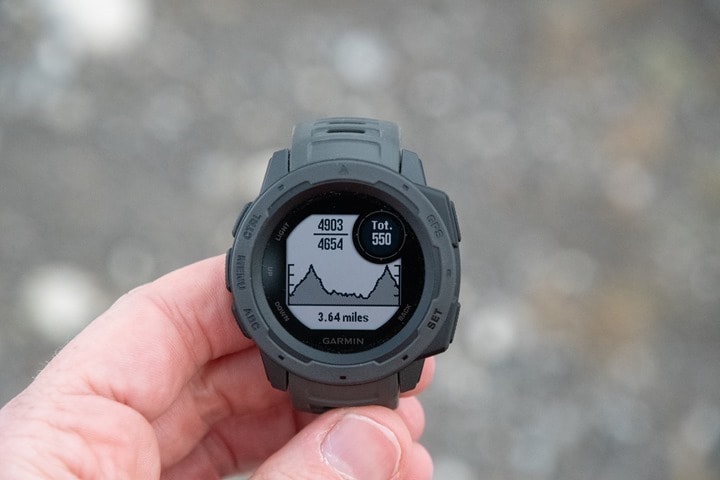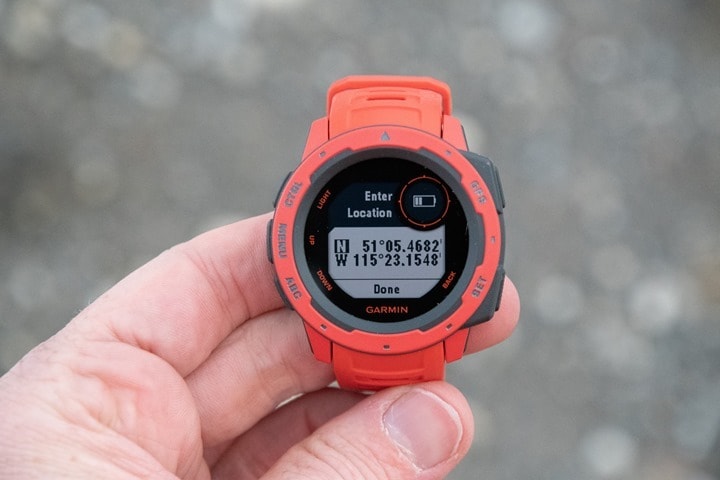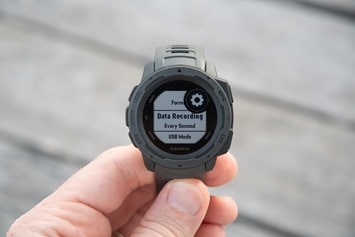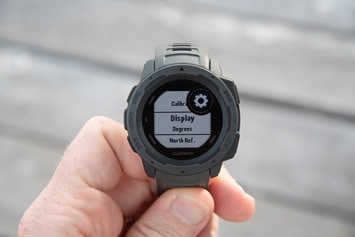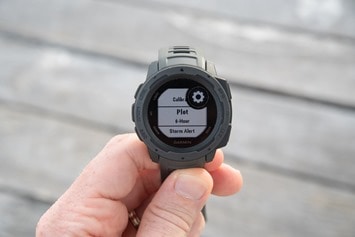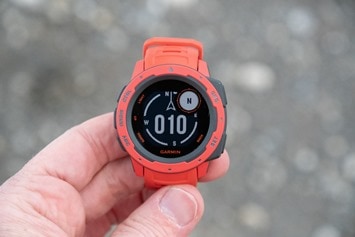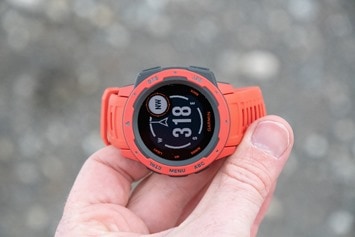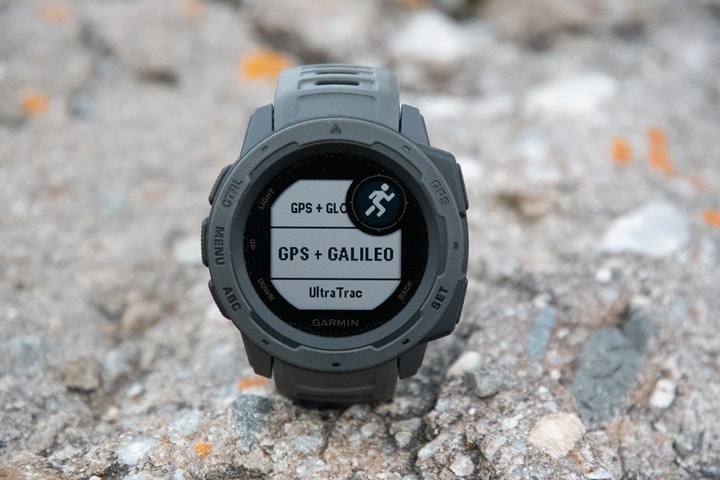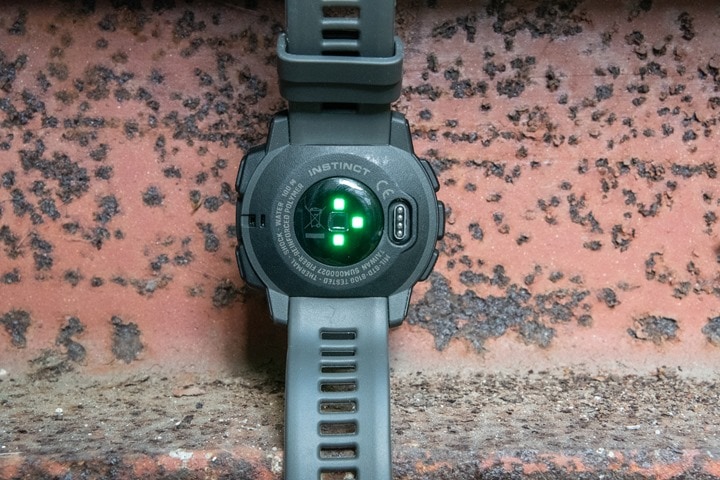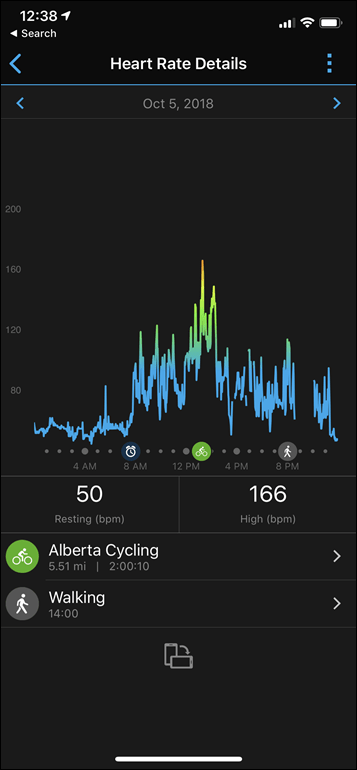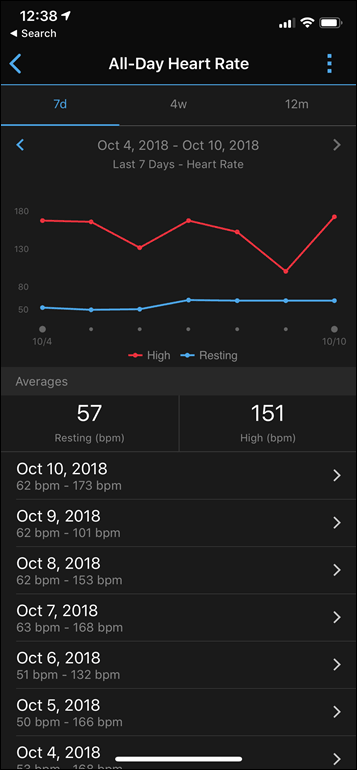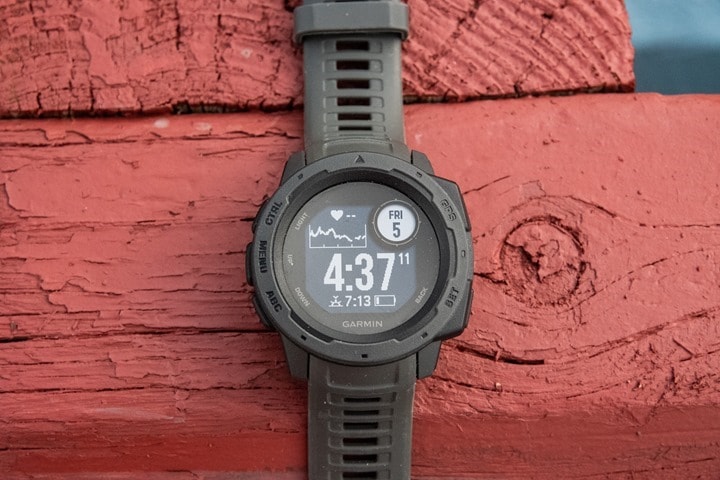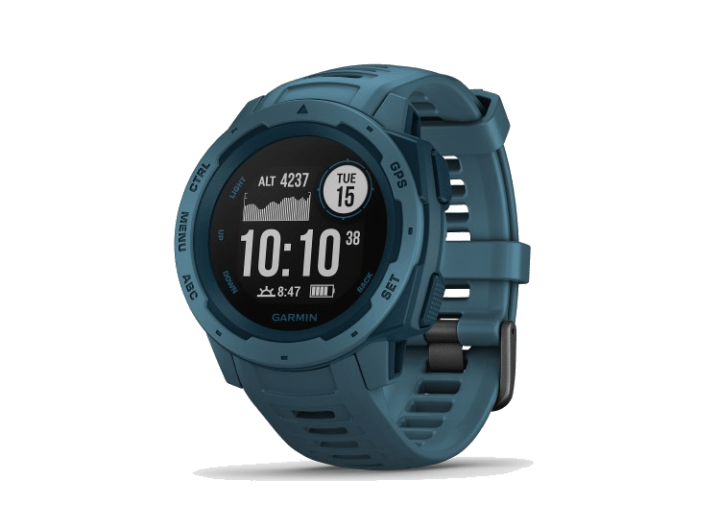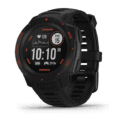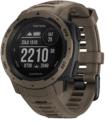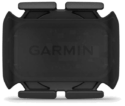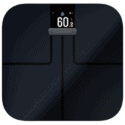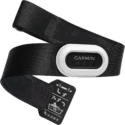When it comes to looks, you’re either going to love or hate the new Garmin Instinct watch. There’s not likely to be much middle ground. If you like the looks of Casio watches, you’ll probably be pretty excited about this unit. Whereas if you prefer less 1980’s style, you’ll probably end up skipping this unit. In which case you can return to your regularly scheduled programming.
If however this style is for you – then we can get into the details of it. The Instinct watch comes from Garmin’s Outdoor division, which is the same group that owns the Fenix lineup as well as other hiking/mountain focused wearables/devices. Still, no matter the mother, this unit from a features standpoint is essentially the blend between a Vivoactive 3 with that of a pile of Fenix features. Oh, and of course: The looks of a Casio.
But, as you’ll see – it’s not quite as simple as that. While the $299 Instinct has a huge flotilla of navigation-specific features not found in the $249 Vivoactive 3, it’s also lacking a pile the Vivoactive 3 has. The devil’s in the details, though, for most outdoor/hiking focused folks – I suspect this might actually hit the sweet spot. If you’re looking for all the details in one consolidated video, then dig no further than the YouTube goodness that follows:
I’ve been using the Instinct for a bit over a month now on rides/runs/hikes (including in the mountains), plus just general wanderings. As usual, once I’m done with this media loaner I’ll ship it on back to Garmin and go out and get my own. Just the way I roll. You can hit up the links at the end of the post if you want to help support the site.
With that, let’s get it unboxed.
What’s in the box:
The Garmin Instinct box is pretty minimalist, despite its size. It also looks like most other Garmin boxes these days. Note that there are a few different colors of Garmin Instinct units, which you’ll see in this review. The vast majority of the time I was wearing the grey one.
The watch itself is nestled in cardboard, while the cable has protection on it so that it doesn’t get too frisky during any prolonged cold winter nights alone.
Here’s all three bits inside the box once dumped out onto a table:
You’ve got the watch itself, alongside the charger. It’s the same charger as used by most other Garmin wearables these days.
And then you’ve also got the manual/paper bits in there, though realistically you probably won’t read that after this post, since that basically just covers safety stuff and that if you kill yourself using the watch it’s likely your fault (which honestly, it probably is).
The watch comes in at a weight of 52g:
And that’s it, that’s all I’ve got in the box.
The Basics:
As I alluded to in the intro section, the Instinct is a blend of a Vivoactive 3 and a Fenix watch. One could call it a budget Fenix if they wanted I suppose. It’s more Fenix than Vivoactive 3 in many ways. And to help you understand all those ways, I’ve consolidated this into basically two chunks of bulleted text. The first is features that are different from the Vivoactive 3 series, and the second is some of the bigger features in comparison to the Fenix 5 series.
Starting off first with the Vivoactive 3, here’s how it differs from that unit (if it says it has something, that means the Vivoactive 3 doesn’t have it):
– Has course navigation: Ability to navigate downloaded courses (breadcrumb trail)
– Has compass mode: Ability to enable a compass mode
– Has ABC functions: Ability to access Altimeter/Barometer/Compass features/pages
– Has Elevation Profiles: Ability to see upcoming elevation on courses
– Has Storm Alert: Utilizes barometric altimeter to provide incoming storm alerts
– Has UltraTrack: Gives up to 40 hours of GPS-battery life at reduced recording rates
– Has AutoClimb: Primarily a trail running/hiking option to auto-enabled ascent pages
– Has Sight N’Go: Basically the compass in a simplified mode
– Has Sunset/sunrise/Twilight Times: Self-explanatory
– Has Area Calculation: A feature you’ll never use
– Has Saved Waypoints: To save specific spots you can navigate to later
– Has TrackBack: Allows you to follow course in reverse (different than Back to Start)
– Has Hot Keys: Allows you to assign long-hold presses to specific keys
– Has Garmin inReach support: Can connect to Garmin inReach devices
– Has Garmin Xero support: Can connect to Garmin Xero devices
– Has 3D Distance/3D Speed: Slightly more accurate in steep climbs/descents
– Has openwater swimming: For swimming outdoors in oceans/lakes/etc..
– Has Virtual Partner: So you can compete against a specific pace/time goal
– Has Ability to Race Past Activities: Compete against your past runs
– Doesn’t have VO2Max metrics
– Doesn’t have Connect IQ support: No data fields, apps, or widgets
– Doesn’t have Garmin Pay support: No contactless payment support
– Doesn’t have onboard music support: No local music storage like Vivoactive 3 Music
– Doesn’t have golf mode
– Doesn’t have WiFi: Used by Vivoactive 3 Music for music access
Phew!
But wait, we aren’t done. To very briefly cover a few things this doesn’t have compared to the higher end Fenix 5 series, I’ve put together the below list. Note, because the Fenix 5 series has so many features, I’m just covering some of the ones below that I suspect will be FAQ’s. I wouldn’t consider this list exhaustive by any means. Again, this is comparing the Instinct to the Fenix 5 series (for features that it doesn’t have above already, I haven’t re-duplicated them below).
– Doesn’t have PulseOx SpO2 measurements: Both the Fenix 5X Plus and Vivosmart 4 have this
– Doesn’t have Body Battery metrics
– Doesn’t support power meters, bike lights, bike radar
– Doesn’t have onboard maps like Fenix 5X and Fenix 5 Plus series
– Doesn’t cost $1 million dollars
Ok, now you can breathe a sigh of relief. And depending on what you’re looking for, you can either keep reading or close this tab and go off and look at cat videos on YouTube. Your choice.
So let’s get into the basics of the watch. And the most obvious thing you’ll notice right away is that display – it’s quite different from any past Garmin wearable.
Thus, it’s probably best to talk about the watch face first, which is configurable to a degree. There are in fact twelve watch faces you can choose from, which is notable since there are zero you can download from Garmin Connect IQ – as somehow it doesn’t support that. Yes, I’m going to beat that hammer a lot in this review. Here’s a nifty gallery of all the watch faces:
What’s cool is that every element on many watch faces is customizable. Take the default one for example (which is actually my favorite). Every bit of data on it you can tweak, including what’s shown in the mini-display. So if you want to show steps instead of heart rate on the little graph on the left, you can. If you want to show the battery in the bubble, you can. The world’s your oyster, as long as that oyster isn’t on Connect IQ.
Oh, before we go too much further, let me show you what it looks like on my wrist:
As you’ve probably guessed, this isn’t a touch-screen device, and so instead you’ll use the buttons like most Garmin devices. The button layout is identical there to the Fenix series, though the menus might feel a bit different at times. There’s some slight tweaks there, some good and bad. For example, you’ll see little icons in some menu choices now – kinda like the browser tab icon on favorited websites. This is also used within sport mode too, for example below, to show that the watch is paused. It’s actually a nice touch.
Meanwhile, flipping it over you’ve got Garmin’s ELEVATE optical HR sensor along with their mostly-used standard charging port. This is the same port used on the Fenix 5 series, the Vivoactive 3 watches, and a slew of other units over the last 2 years. It does support charging mid-activity, if you need extra juice to complete your workout. Just use any USB battery pack and you’re good to go.
It’s also ‘Mil-spec’ rated as MIL-STD-810G, which in consulting with Wikipedia actually has a mind-bogglingly long list of tests they do. In my video I give it a few good tosses against some Canadian boulders to see what happens. Spoiler: It survives just fine.
Looking at that heart rate sensor, it’ll constantly monitor and record your heart rate, 24×7 at 1-second intervals. All of that information is then transmitted to the Garmin Connect mobile app, and from there you can view daily trends. This same sensor is used during workouts as well, but more on that later.
Below you can see a plot from last week. At the mid-point of the day you can see the two-hour bike ride, showing the elevated heart rate. You’ll also see automatically detected sports on here (like walks), if applicable, as well as any manually triggered workouts.
The heart rate data feeds into Garmin’s stress tracking modules as well, which are shown on both the watch itself as well as the Garmin Connect mobile app. It’s fun to see how the stress matches up to heart rate over the course of the day. Usually I find it matches fairly well compared to how stressful I actually am.
Of course, like virtually every Garmin device except their car GPS units, it’ll track steps, sleep, and stairs as well. The stairs and steps bits can be seen on the watch itself in a number of ways. You can see it on the watch face itself, placed into a ‘My Day’ summary widget, or even individually as widgets.
And of course you can see it online on the Garmin Connect mobile app too:
And the same goes for sleep, which is also available online with Garmin Connect mobile app. Note that there’s nothing to do on the device itself in terms of sleep. It’s all auto-detected, and at this point Garmin doesn’t support naps either – so if you take a nap that just goes into nowhere land. Overall though, from a sleep detection accuracy standpoint, things are pretty good for me.
The unit also includes smartphone notifications, though sometimes on the small screen they can be a bit harder to get the full message at a glance because there’s not a ton of character space to work with. But you can tap them to look at historical ones as well as get the full details.
Additionally, the unit will display weather as pulled from nearby weather stations. This is using your phone’s cellular connectivity, via Bluetooth Smart to the watch. For things like barometric pressure, altitude, and temperature, that’s displayed natively from the watch on other data pages that I touch on a bit later.
Finally, from a basics standpoint the battery life of the unit is claimed at 14 days in regular watch mode (no GPS enabled), and 16 hours in GPS-on mode. It claims 40 hours in GPS-on mode with UltraTrac enabled. I’d say these claims are in the ballpark based on my usage. Of course, like most people I don’t tend to do 16hr hikes every day, nor do I just use my watch sans-GPS either for 14 days. But the battery seems to easily last me a week with about an hour of GPS activity each day (on average).
Sport Usage:
When it comes to sport use, the Instinct is pretty similar to that of the Vivoactive 3, and carries with it the vast majority of the sport modes (except golf). It’ll utilize the optical HR sensor on the back of it to measure your heart rate during workouts, though it can connect to external heart rate sensors as well as cycling speed/cadence sensors. It can also connect to Garmin inReach devices and Garmin Tempe temperature sensors.
From a sport mode standpoint, you’ll select your favorites for quick access, which are then accessible by tapping the upper right button. That takes you to the sport selection menu:
Note that unlike Garmin’s Vivoactive series watches, it does support openwater swimming (to match the Fenix series). It also supports pool swimming though and just about every other sport you can think of (in the video I scroll through all the sports).
After choosing a sport, it’ll start searching for sensors, as well as GPS (if applicable):
It’s here via the menus that you can go ahead and change settings for a given sport, including data pages and the metrics shown on those pages. In fact, the Instinct offers a number of unique data page layouts, mainly due to its mini-display bubble. There’s about half a dozen different layouts that are possible with varying numbers of data fields per layout.
You can customize each and every one of those spots to create some pretty unique data page layouts with up to five pieces of unique information per page. Additionally, you can add in pages like the map, compass, elevation, music controls (from your phone), and virtual partner.
Note that since this watch doesn’t (inexplicably) support Garmin Connect IQ, that means you can’t use 3rd party data fields like those from Stryd or others. It also means you can’t use Garmin’s own running power either, since that depends on Connect IQ too.
You can race past activities (such as my bike ride below) or downloaded activities, which leverages the Virtual Partner function. Of course, you can also use the Virtual Partner function in a standalone setup to race against a specific goal time. Instinct also supports custom workouts (that you can create/download/etc online), as well as an onboard interval function.
Sport modes like running and hiking (among others), also include the usual options like auto lap (based on distance), auto pause, auto scroll, and auto climb. It’s auto-climb that’s a carryover from the Fenix side of the house and leverages the barometric altimeter to automatically add ascent related climbing pages when you start going up a hill. Those pages disappear when you’re on flat land.
Further, like most of Garmin’s 2018 lineup, you’ve now got access to Galileo satellites if you so choose. That’s in addition to regular GPS and GPS+GLONASS. Related to that, you’ve got access to UltraTrac, which reduces the GPS recording rate significantly but saves battery life. Garmin claims 40 hours of GPS-on time in that mode. I’d have no issues using that for ultra-hikes, but I wouldn’t use it for day to day runs/rides/etc, as it truncates too much of the track. Note that for the regular GPS modes you can configure either smart or 1-second recording.
In any case, once you’ve picked your sport and acquired satellites (if applicable), you can press the upper right button to start recording. Also, if you wanted to navigate, you can add that at any time via a long-hold of the middle-left button. But I cover that in the next section.
While running/riding/hiking/etc, you can iterate through the data pages by pressing the up/down buttons (or, use auto-scroll to have it do it constantly). If you want to create a lap marker, you’ll press the lower right button. However, you do need to turn that on, as by default the lower right button takes you to the watch face. To turn it on simply go into the sport mode option and set ‘Lap key’ to enabled.
The unit includes both audible and vibration alerts, both of which can be individually enabled/configured in the settings. For the most part, the buttons mirror that of other Garmin wearables, including the Fenix lineup. That’s probably why you see the hot key support in here, which allows you to customize what happens when you long-hold a given button. Basically, they’re like shortcuts:
After you’re done with your workout/activity your data will be saved to the watch as well as then synced to Garmin Connect Mobile. If you’ve got 3rd party apps connected/authorized like Strava, MyFitnessPal, or others it’ll also get sent to them too.
On the Garmin Connect Mobile app you can view your workout and a crapton of stats from it.
These are also accessible from the main website as well, here’s an activity from yesterday for example.
Finally, note that you can change settings like statute/metric display, as well as position formats in the settings menu for the watch as a whole. For example, you can set a preference that you show altitude in metric but pace in statute, and then even distance back in metric. Whatever floats your boat.
Navigation:
If there’s any portion of the Instinct that makes you realize it’s no Vivoactive, it’ll be all the navigation features. Effectively, it’s a mini-Fenix. Sure, it doesn’t have fancy maps like the Fenix 5 Plus series does, but neither did almost every other Garmin wearable until that point. To quickly bulletize the navigation-specific features it does have, here’s a handy list:
– Magnetic Compass (and thus, ‘Sight N’Go’ mode)
– GPS Coordinate Display/Navigation
– Course Navigation (breadcrumb style)
– Sunset/sunrise/twilight times
– Area Calculation
– Storm Alert leveraging Barometric Altimeter
– TracBack (as well as Back to Start)
– Elevation Profile display (within a course)
– Hot keys (a Fenix-specific feature)
– 3D Distance/Speed, Vertical Ascent/Descent data fields
That’s the quick version, but in this section I’ll dive through some of these in more detail. The biggie in here is support for courses. Of course, courses are hardly new to Garmin devices, and if you’re familiar with the functionality on other Garmin wearables – then it’s almost identical here. The only minor difference here is that when navigating a course you get the compass shown in the mini-display. Beyond that, same-same.
But for those unfamiliar, courses allow you to follow a pre-planned route. You can make that on Garmin Connect (online or via mobile app), as well as even create courses on the unit itself with saved points. Here’s a relatively convoluted course I made on some trail running routes near where I was last week. I created this one online, though you can also use Basecamp too offline.
Once that’s done, I used the Garmin Connect Mobile smartphone app to push it to the watch via Bluetooth Smart:
After which I dive into the courses menu within navigation. When it comes to following a course, that’s generally considered detached from a specific activity. So I can choose run/hike/trail run/cycling, etc.. and then go ahead and choose the course. You can technically navigate just a course without an activity, but the vast majority of the time you’ll do it as part of a session you’re recording.
Once a course is loaded up you’ll see a breadcrumb trail of where you’re going, and as well as details about remaining time on the course. You can zoom and pan within the course as well by holding the menu key for a moment and opening up the pan/zoom menu.
You can also get your current position on the course elevation profile, and if you’re off-course you can use the little mini-compass to get yourself back on-course. Since it’s magnetic based, it’ll correct instantly as you rotate the watch (check out the video where I show this in-action).
Of course, since this has no awareness of things like lakes/streams/mountains/roads/railroads/etc, if you get yourself significantly off-course where one of those objects comes between you and the course, it’s up to you to figure that out yourself. That’s different than something like the Fenix lineup where you can see the objects on the detailed map. Also, this unit doesn’t support features like local points of interesting (restaurants/shops/monuments/etc…).
However, like the Fenix lineup, you can also save your current position, as well as navigate via GPS coordinates. From a GPS coordinates standpoint it supports display of GPS coordinates in either Degrees or Mils.
Additionally, it will leverage the barometric altimeter to trigger storm alert warnings, should your luck be low. In my case, I didn’t manage to trigger one. You can change the storm alert settings within the barometric altimeter sensor settings, including calibration. This is the same spot you can also recalibrate the compass as well.
By default, the unit will auto-calibrate the altimeter leveraging the GPS data as a starting point, however, you can disable that. And of course you can switch between meters and feet for just elevation if you want (handy for Americans like myself that often prefer using meters for elevation when hiking in meter-driven countries, but want to leverage miles for distance). Finally, like the Fenix series you can add the compass, barometer, or altimeter as individual quick access widgets to the watch.
Or, you can also add the blended ABC widget as well too. The widgets are handy because you can access them outside a sport mode, so you don’t have to tie yourself to a recorded activity or GPS if you don’t want it.
Also note that the Instinct includes Garmin’s ‘Sight-N-Go’ functionality, which is just a fancy name for real-time magnetic ‘compass’. You can see below how when I rotate it in my hands, the heading changes. This may sound/be obvious, but for non-magnetic compass watches, it won’t change until you actually move forward.
Ultimately, I was fairly impressed with how much functionality they took from the Fenix lineup. Perhaps even too much functionality, but I also suspect that the majority of purchasers of the Fenix lineup are specifically selecting that watch over equally capable watches (like the FR935 that has identical sport/hiking features), mainly because of the looks.
GPS and Elevation Accuracy:
There’s likely no topic that stirs as much discussion and passion as GPS accuracy. A watch could fall apart and give you dire electrical shocks while doing so, but if it shows you on the wrong side of the road? Oh hell no, bring on the fury of the internet!
GPS accuracy can be looked at in a number of different ways, but I prefer to look at it using a number of devices in real-world scenarios across a vast number of activities. I use 2-6 other devices at once, trying to get a clear picture of how a given set of devices handles conditions on a certain day. Conditions include everything from tree/building cover to weather.
Over the years, I’ve continued to tweak my GPS testing methodology. For example, I try to not place two units next to each other on my wrists, as that can impact signal. If I do so, I’ll put a thin fabric spacer of about 1”/3cm between them (I didn’t do that on any of my Instinct activities however, all workouts only had a single device per wrist). But often I’ll simply carry other units by the straps, or attach them to the shoulder straps of my hydration backpack. Plus, wearing multiple watches on the same wrist is well known to impact optical HR accuracy.
Next, as noted, I use just my daily training routes. Using a single route over and over again isn’t really indicative of real-world conditions, it’s just indicative of one trail. The workouts you see here are just my normal daily workouts.
I’ve had quite a bit of variety of terrain within the time period of Garmin Instinct testing. This has included runs in: Amsterdam, San Francisco, Reno, Tahoe, Banff, and Cancun. Cities and mountains, trees and open-air. It’s been everywhere!
First up we’ll start with something relatively easy, my run yesterday. I say easy because basically it’s just along a running path. While there were actually plenty of tall palm trees above me, they were mostly to one side. So, pretty straightforward (here’s the set link, which you can click on and dig into any of the items in more interactive detail.)
So at a high level things look pretty good. Which honestly at this far zoomed out you’d hope they’d all match. In this case it’s compared against an Apple Watch Series 4 on the other wrist, and then a Suunto Trainer Wrist HR being hand-held pointed upwards.
Now for the below zoomed in GPS plot I changed the Instinct’s GPS track to bright red so it’s easier to see. You can see that in one direction it’s basically the same as the others, whereas going the other direction it’s off in the woods a bit. Not massively so – but my guess is 3-8 meters away, here and there. There’s no real logical reason for it. In this particular test I actually changed back to GPS+GLONASS (from Galileo GPS) as I was curious to see the differences.
As I scroll along the road, I can continue to see these imperfections. Hardly massive deals, but also not spot-on either.
For example at the turn-around it appeared the watch wanted to go play with the dolphins instead:
So how’d this impact distance? Well, that’s what is somewhat funny here – is that it somehow undercut distance. A fact I noticed when I was doing intervals and my pace was slower than expected (since it was undercounting distance). For virtually every set the other watches (plus The Girl’s Fenix 5s Plus) were recording more accurate paces/distances. Odd.
So, let’s look at another run, this one from a few days ago along roughly the same path, but in a different direction towards the taller hotels. Don’t worry, we’ll get to the mountains in a moment. Just stepping it up, one notch harder per set. At a very high level, it looks mostly fine.
But let’s zoom in on a section (it really doesn’t matter what section you zoom in on, they’re all about the same):
And another for good measure:
As you can see, more of the same wobble. Generally, it’s just not as clean as the others. There are exceptions to that, for example this section here:
And then this section here when we’re next to tall buildings and a large wall in a resort area, the watches are all about the same, each with their own occasional hiccup:
Still, despite these good sections – it’s clear that in the grand scheme of things this watch didn’t perform as well as the other two. Note that in this case the watch was on GPS+Galileo, at one-second recording rates.
Still, let’s leave the warm weather behind and head up into the cold as crap mountains. This time up in Banff, Canada with snow and ice-covered roads with tall trees and mountains around us. In fact, the reason you see that random line between two points on the course is when we fell, and the timer got paused on the Suunto Trainer (thus, it’ll impact the total distance there). No worries, it’s still easy enough to compare tracks.
Let’s zoom in a bit here on some sections. In this case you can see here for this upper portion that things were spot-on. All the units were aligned to the road (where we were), save the moment the other watch got stopped. Very solid.
And if we go down towards the bottom of the loop – it also looks pretty good. A little bit of difference between the three watches at the very bottom with the Suunto a bit more off-track, and then the Apple Watch probably holding the most correct line. But again, all very very close there.
Finally, if we look at the starting/ending point, the units are close – but we do see a tiny bit of wobble by the Instinct in one direction once or twice, again by my guess of about 5-10 meters outbound for a few seconds. The one blip where all watches go off the road isn’t us falling again, but rather going to get pictures of elk.
Next, we’ll head to some warmer mountains – this time for a two-hour hike I did. In this case it’s compared against the Garmin Fenix 5 Plus and the Suunto Trainer Wrist HR. Here’s the data set.
Obviously with switchbacks and such it’s a bit harder to see, so I’ll dive into a few chunks:
At this level you can see there aren’t any major variations. Figuring out exactly where the trail is versus where the paths are is tough, even if you zoom all the way in and turn on satellite view:
The key thing you’re looking for in this kind of scenario (which is all tall trees initially, and then it gets thinner up higher elevation), is that nobody is totally out in left field. And for the most part, that seems to be the case:
Since this was largely a hike upwards, let’s take a quick look at elevation gain:
In this case the two Garmin units matched very closely. This specific Suunto unit doesn’t have a barometric altimeter (unlike these two Garmin’s), so it’s using GPS elevation for these points. Still, all three track very closely to each other. I don’t have a specific reference elevation however to validate one way or the other unfortunately. Sometimes you’ll pass such signposts, but I didn’t see any on this trail to compare against.
Still, what I tend to focus on in most elevation tests (when I lack a signpost), is that we don’t see drift in the altimeter where the separation closes. So all good here.
For those that want to dig into another set, this time biking in the snow in the mountains, you can check out this link here. It shows the elevation differences a bit, but the tracks are very similar. Both wrist watches were under my heavier winter layers too.
Finally, here’s a more flat setting, this one a multi-hour bike ride along the canals of Amsterdam. Obviously, at a high level it looks great.
And frankly, no matter where I zoom in – it’s boring. It’s all perfect. Which is almost always the case for road cycling GPS tests:
The only point that anyone flinches is when we stop for coffee and I go inside, and it’s only the Apple Watch that struggles.
And here again:
So, wrapping things up a bit. In general the GPS accuracy is OK, but definitely not the best I’ve seen from Garmin. The ‘wobble’ that you see in the runs in more open conditions is quirky, though, it doesn’t seem to happen in harder conditions (like mountains or forested areas). It’s unclear to me why this is. It doesn’t seem to happen on hikes or bike rides either.
Perhaps it’s something in the specific area I’m at right now, or perhaps it’s a bug Garmin can sort out. I don’t think it dramatically impacts most people’s distance, but certainly it does have an impact to a small degree.
(Note: All of the charts in these accuracy sections were created using the DCR Analyzer tool. It allows you to compare power meters/trainers, heart rate, cadence, speed/pace, GPS tracks and plenty more. You can use it as well for your own gadget comparisons, more details here.)
Heart Rate Accuracy:
Next up we’ve got heart rate accuracy. This roughly falls into two buckets: 24×7 HR, and workout HR. As is usually the case with most devices these days, I see no tangible issues with 24×7 HR. It works well across both normal daily routines as well as things like sleep. Speaking of which, I talk about RHR values and 24×7 monitoring here and why it’s interesting.
Before we move on to the test results, note that optical HR sensor accuracy is rather varied from individual to individual. Aspects such as skin color, hair density, and position can impact accuracy. Position, and how the band is worn, are *the most important* pieces. A unit with an optical HR sensor should be snug. It doesn’t need to leave marks, but you shouldn’t be able to slide a finger under the band (at least during workouts). You can wear it a tiny bit looser the rest of the day.
Ok, so in my testing, I simply use the watch throughout my normal workouts. Those workouts include a wide variety of intensities and conditions, making them great for accuracy testing. I’ve got steady runs, interval workouts on both bike and running, as well as tempo runs and rides – and even running up and down a mountain.
For each test, I’m wearing additional devices, usually 3-4 in total, which capture data from other sensors. Typically I’d wear a chest strap (usually the HRM-TRI or Wahoo TICKR X, but also the Polar H7), as well as another optical HR sensor watch on the other wrist (and usually also a Scosche Rhythm 24). Note that the numbers you see in the upper right corner are *not* the averages, but rather just the exact point my mouse is sitting over. Note all this data is analyzed using the DCR Analyzer, details here.
Note that while I’ve been using the Instinct for about a month, I’m mostly going to use recent data in this review – since that’s the firmware that it’s currently on and the production firmware that real world people are using.
First up from a heart rate standpoint is a relatively simple run in Mexico. I say simple in that there wasn’t any intervals or other complexities from a pace standpoint. Just straightforward slight ups and downs. It’s compared against an Apple Watch Series 4 on the other wrist, and then a TICKR-X heart rate strap via a Suunto Trainer Wrist HR. Here’s the data set:
As you can see above, things are honestly pretty darn similar between the three. I see some slight nuances to the TICKR-X HR (wobbles), but that’s not of concern with respect to the Garmin Instinct’s HR. All of them are super close. There’s one minor blip of a second or two early on at about the 2-minute marker, but then it clears ups. Even later on when we pause to walk for a few seconds around the 30-minute and 41-minute markers, the HR drops quite nicely:
Of course, you can see the wonkiness in that TICKR strap a bit more here. Seriously, I need to figure out if that’s an issue with the TICKR or perhaps the recording unit, or perhaps me. I’ve seen it repeatedly for a while. Or I just go and grab another HR strap from the bin (it’s gotta be dual ANT+/BLE though).
In any case, let’s switch to another run, this time a bit of an interval run. This one has a 10-minute build, followed by about 5 minutes of warm-up, and then we do 400m repeats for a while. A long while. Here’s that set. The Instinct is in red.
This actually isn’t too bad. The TICKR-X is definitely struggling a bit here, perhaps because I’m pouring with sweat outside in the humidity (a common issue with HR straps when you get too sweaty and the sweat pools a bit). Still, if you look at the Apple Watch and Instinct, they are actually pretty close to each other. During some of the intervals the Instinct seems to be a bit delayed during the recovery, but then catches up again:
In general, if a watch has to screw-up either the ramp into the interval or the recovery, I’d prefer it to screw-up the recovery (as it did here). It seemed to get better though. If there’s any takeaway of note here is that the Apple Watch Series 4 did really good. Perhaps that new sensor design is paying off.
Note that the build portion here was pretty good though for Garmin, and in fact the one area where again the Apple Watch does a delayed acquisition of heart rate. It’s so painfully obvious in all these charts with that flat-line to begin.
Next, let’s switch to a cold-weather run. This time sub-zero (Celsius) temps up in Canada. The watch was under my long-sleeve shirt/gloves, but still, cold weather is the arch nemesis of optical heart rate sensors. I often joke that companies that release watches mid-winter are at a fundamental disadvantage when it comes to accuracy testing due to this (Pro Tip: Don’t release an optical HR sensor watch mid-winter). Here’s that set.
Note that we fell at one point on the ice, and as part of that the Suunto watch got paused for a few minutes before I noticed (that has with it the TICKR-X HR data). You can see that around the 9-minute marker where it flat-lines.
So I’d categorize the first minute of this run as a general cluster-fudge from a HR standpoint between the three units. However, process of elimination actually makes this relatively easy. Clearly my HR didn’t start at 170bpm, so the TICKR is wrong there. And clearly it didn’t start and stay perfectly flat-line at 145bpm like the Apple Watch says. Instead, it likely did what the Garmin Instinct says, which is a nice slow build from 110bpm upwards. Given what I know about our pace and effort, that’s an entirely logical climb in HR.
In any case, it then continues to be a general mess until about the 6-minute marker when all three agree:
Interestingly, my hand-drawn ‘M’ looks like the golden arches from McDonald’s. Also of note is that it’s actually fairly likely that the Instinct was most correct throughout this entire bit. The only questionable part is where it jumped up around the 5:29 marker, simply because typically optical HR sensors don’t detect increases in intensity before chest straps, but this did. Still, it certainly does happen.
After that point, we go over some rolling terrain. And by rolling, I mean we slid down an icy hill together like two bowling pins, knocking each other out. It was a generally non-ideal situation. One of us broke our phone in the process. But no limbs were broken, nor even ego’s bruised. So we continued on.
Fast forwarding past the part where the chest strap watch had gotten paused in the fall, you can see the remainder of the run the units are very close. While the HR isn’t going through major swings, the range of HR’s here is upwards of 170bpm and then back to 150bpm, so some good change in intensity. And towards the end where we stopped to check out some elk, the HR’s dropped nicely, and when we started running there was zero delay from any of the sensors.
All in all, a pretty good effort actually.
So let’s switch over to some cycling. We’ll start first with this 30×30 set indoors. By 30×30 I mean 30-seconds hard followed by 30-seconds of recovery. I use this for cycling power meter testing, but it’s actually really interesting for optical HR testing as well. Here’s the data set:
Hmm. Not such a good start. Keep in mind this is technically only showing it against the TICKR-X, but that heart rate strap more or less nails it from an intensity standpoint. You can clearly see the 8 sets of 30-seconds on and off within it. Whereas the Instinct is pondering life for the first half of the ride (it’s only a 12-minute test). What’s interesting is especially the first minute or two where the Instinct actually mirrors the ups/downs of the HR, but is heavily offset (low).
It’s around the 4th set of the 30×30’s that the Instinct seems to realize the error of its ways and gets onboard the right boat. At that point it’s pretty much spot-on the entire remainder of the ride, save for the last few seconds.
Typically I see less than awesome performance on a bike, but it’s actually somewhat unusual to see sucky performance indoors. And while sometimes I see poorer performance if I’m doing something else with my hands at that time, that didn’t happen here because in these 30×30 tests I don’t have the brain-power to do anything other than pedal for my life (it’s 430w for each 30-second on period).
Still, let’s head outside. Here’s a two-hour ride on relatively smooth ground with virtually no stops, except for coffee of course. Because we’re in Europe, and that’s how we do things in Europe (and Australia). Here’s that data set.
You’ll notice where things go all-different is the coffee stop. I actually purposefully don’t stop the watches for stops during testing, because there are often nuanced differences to how different GPS devices record stopped time. If those differences don’t match between different devices, then the overlays go to crap. So just ignore the coffee stop.
Like most of the others here; this was compared against the Apple Watch Series 4, a TICKR-X connected to a pile of bike computers, and then the Garmin Instinct’s optical HR sensor of course.
And honestly, all in all, this actually isn’t too bad. I’ve put smoothing at 10-seconds for this chart to make it easier to see over the duration of the ride, but frankly this might actually take the cake as the best optical HR performance I’ve ever seen from a Garmin device on a bike. Keeping in mind that historically speaking that’s been a pretty low bar. And as you can see, it’s hardly without some solid errors. Zooming in on the first portion, you can easily see some of these.
Above are two and a half tell-tale Garmin optical HR sensor errors while cycling. The first is the delayed reaction – in this case, almost 30-seconds late. The second is just entirely missing stops/pauses. In this case, stops at a stoplight whereby the Garmin simply just keeps on trucking as if nothing ever happened. The chest strap and Apple Watch match perfectly, whereas the Garmin…well, doesn’t appear to want to stop riding.
That said, after the coffee stop things mostly settled out. A bit of toughness immediately following the stop, but mostly good. And it’s not to say the Apple Watch is perfect either. Around the 1:56 marker you can see (right below the word ‘Heart’ below), where the Apple watch mirrors the same thing as the Garmin did earlier, albeit for only a handful of seconds.
In general my guidance remains mostly unchanged for wrist optical HR sensors while cycling: If doing any sort of interval work, fast changes of pace, or rougher terrain – I’d stick with a chest strap or other upper-arm based optical HR sensor (Scosche, Polar OH-1, TICKR FIT), which tend to handle cycling better. But in a pinch, you can use the optical HR sensor on the Instinct devices for cycling and it’ll get the general gist of things correct most of the time.
Ultimately the optical HR sensor on the Garmin Instinct is basically the same as I’ve seen on other recent Garmin wearable products. It’s mostly good for activities like running or hiking for me, but it tends to be a bit rougher for cycling and intervals or fast changes of pace within cycling. As usual with optical HR sensors, your mileage will vary.
Product Comparison:
I’ve added the Garmin Instinct into the product comparison database, allowing you to compare it against other products that I’ve reviewed in the past. For the purposes of the below tables I’ve compared it against the Vivoactive 3 (non-music), the Fenix 5 Plus, and the Suunto Spartan Trainer Wrist HR. I added the Spartan because from a navigation standpoint it’s somewhat in-line, though note the lack of barometric altimeter on that lower-end Spartan unit. I might consider adding in the most recent Casio unit into here as well.
| Function/Feature | Garmin Instinct | Garmin Fenix 5 Plus (5/5S/5X) | Garmin Vivoactive 3 | Suunto Spartan Trainer Wrist HR |
|---|---|---|---|---|
| Copyright DC Rainmaker - Updated July 11th, 2023 @ 3:06 am New Window | ||||
| Price | $299 | $699/699EUR | $129 | $279 ($329 for metal bezels) |
| Product Announcement Date | Oct 11th, 2018 | June 17th, 2018 | Aug 31st, 2017 | August 10th, 2017 |
| Actual Availability/Shipping Date | October 2018 | June 17th, 2018 | September 2017 | August 30th, 2017 |
| GPS Recording Functionality | Yes | Yes (with Galileo too) | Yes | Yes |
| Data Transfer | USB, BLUETOOTH SMART | USB/Bluetooth Smart/WiFi | USB, BLUETOOTH SMART | USB & Bluetooth Smart |
| Waterproofing | 100 meters | Yes - 100m | 50 meters | Yes - 50 meters |
| Battery Life (GPS) | Up to 16 hours GPS (40hrs in UltraTrac) | Up to 32hrs in GPS-on, up to 85hrs in UltraTrac GPS (varies by model) | Up to 13 hours GPS | Up to 30 hours |
| Recording Interval | 1s or Smart Recording | 1S or Smart | 1s or Smart Recording | Variable |
| Alerts | Vibrate/Visual/Audio | Vibrate/Sound/Visual | Vibrate/Visual | Visual/Vibrate |
| Backlight Greatness | Great | Great | Great | Great |
| Ability to download custom apps to unit/device | No | YEs | Yes | No |
| Acts as daily activity monitor (steps, etc...) | Yes | Yes | Yes | Yes | Music | Garmin Instinct | Garmin Fenix 5 Plus (5/5S/5X) | Garmin Vivoactive 3 | Suunto Spartan Trainer Wrist HR |
| Can control phone music | Yes | Yes | Yes | No |
| Has music storage and playback | No | Yes | No | No |
| Streaming Services | N/A | Spotify, Amazon Music, Deezer, iHeartRadio | Payments | Garmin Instinct | Garmin Fenix 5 Plus (5/5S/5X) | Garmin Vivoactive 3 | Suunto Spartan Trainer Wrist HR |
| Contactless-NFC Payments | No | Yes | Connectivity | Garmin Instinct | Garmin Fenix 5 Plus (5/5S/5X) | Garmin Vivoactive 3 | Suunto Spartan Trainer Wrist HR |
| Bluetooth Smart to Phone Uploading | Yes | Yes | Yes | Yes |
| Phone Notifications to unit (i.e. texts/calls/etc...) | Yes | Yes | Yes | Yes |
| Live Tracking (streaming location to website) | Yes | Yes | Yes | No |
| Group tracking | No | Yes | No | No |
| Emergency/SOS Message Notification (from watch to contacts) | No | No | No | No |
| Built-in cellular chip (no phone required) | No | No | No | No | Cycling | Garmin Instinct | Garmin Fenix 5 Plus (5/5S/5X) | Garmin Vivoactive 3 | Suunto Spartan Trainer Wrist HR |
| Designed for cycling | Yes | Yes | Yes | Yes |
| Power Meter Capable | No | Yes | With some Connect IQ apps | Yes |
| Power Meter Configuration/Calibration Options | N/A | Yes | N/A | Yes |
| Power Meter TSS/NP/IF | N/A | Yes | N/A | No |
| Speed/Cadence Sensor Capable | Yes | Yes | Yes | Yes |
| Strava segments live on device | No | Yes | No | No |
| Crash detection | No | No | No | No | Running | Garmin Instinct | Garmin Fenix 5 Plus (5/5S/5X) | Garmin Vivoactive 3 | Suunto Spartan Trainer Wrist HR |
| Designed for running | Yes | Yes | Yes | Yes |
| Footpod Capable (For treadmills) | Yes | Yes | Yes | Yes |
| Running Dynamics (vertical oscillation, ground contact time, etc...) | No | WITH RD POD, HRM-TRI OR HRM-RUN (NOT VIA OPTICAL HR) | No | No |
| Running Power | No | With extra sensor | ||
| VO2Max Estimation | No | YEs | Yes | Yes |
| Race Predictor | No | Yes | No | No |
| Recovery Advisor | No | Yes | No | Yes |
| Run/Walk Mode | Yes | Yes | Yes | No | Swimming | Garmin Instinct | Garmin Fenix 5 Plus (5/5S/5X) | Garmin Vivoactive 3 | Suunto Spartan Trainer Wrist HR |
| Designed for swimming | Yes | Yes | Yes | Yes |
| Openwater swimming mode | Yes | YEs | No | Yes |
| Lap/Indoor Distance Tracking | Yes | Yes | Yes | Yes |
| Record HR underwater | No | WITH HRM-TRI/HRM-SWIM (Not with optical HR) | No | Yes |
| Openwater Metrics (Stroke/etc.) | Yes | Yes | No | Yes |
| Indoor Metrics (Stroke/etc.) | Yes | YEs | Yes | Yes |
| Indoor Drill Mode | No | Yes | No | No |
| Indoor auto-pause feature | No | No (it'll show rest time afterwards though) | No | No |
| Change pool size | Yes | YEs | Yes | YEs |
| Indoor Min/Max Pool Lengths | 14M/15Y TO 150Y/M | 14M/15Y TO 150Y/M | 17M/18Y TO 150Y/M | 15m/y to 1,200m/y |
| Ability to customize data fields | Yes | Yes | Yes | Yes |
| Captures per length data - indoors | Yes | Yes | Yes | Yes |
| Indoor Alerts | Yes | Yes | Yes | No | Triathlon | Garmin Instinct | Garmin Fenix 5 Plus (5/5S/5X) | Garmin Vivoactive 3 | Suunto Spartan Trainer Wrist HR |
| Designed for triathlon | No | Yes | No | Yes |
| Multisport mode | No | Yes | No | Yes | Workouts | Garmin Instinct | Garmin Fenix 5 Plus (5/5S/5X) | Garmin Vivoactive 3 | Suunto Spartan Trainer Wrist HR |
| Create/Follow custom workouts | Yes | Yes | Yes | No |
| On-unit interval Feature | Yes | YEs | Sorta (2 preloaded ones, but no customization) | Yes |
| Training Calendar Functionality | Yes | Yes | Yes | Yes | Functions | Garmin Instinct | Garmin Fenix 5 Plus (5/5S/5X) | Garmin Vivoactive 3 | Suunto Spartan Trainer Wrist HR |
| Auto Start/Stop | Yes | Yes | Yes | Yes |
| Virtual Partner Feature | Yes | YEs | No | No |
| Virtual Racer Feature | No | Yes | No | No |
| Records PR's - Personal Records (diff than history) | Yes | Yes | Yes | No |
| Tidal Tables (Tide Information) | No | No | No | No |
| Weather Display (live data) | Yes | Yes | Yes | No | Navigate | Garmin Instinct | Garmin Fenix 5 Plus (5/5S/5X) | Garmin Vivoactive 3 | Suunto Spartan Trainer Wrist HR |
| Follow GPS Track (Courses/Waypoints) | Yes | Yes | No (but some 3rd party apps can) | Yes |
| Markers/Waypoint Direction | Yes | Yes | Yes (to pre-saved spots) | Yes |
| Routable/Visual Maps (like car GPS) | No | Yes | No | No |
| Back to start | YEs | Yes | YEs | Yes |
| Impromptu Round Trip Route Creation | No | Yes | No | No |
| Download courses/routes from phone to unit | Yes | Yes | NO | Yes | Sensors | Garmin Instinct | Garmin Fenix 5 Plus (5/5S/5X) | Garmin Vivoactive 3 | Suunto Spartan Trainer Wrist HR |
| Altimeter Type | Barometric | Barometric | Barometric | GPS |
| Compass Type | Magnetic | Magnetic | Magnetic | N/A |
| Optical Heart Rate Sensor internally | Yes | Yes | Yes | Yes |
| SpO2 (aka Pulse Oximetry) | No | Fenix 5X Plus only | ||
| Heart Rate Strap Compatible | Yes | Yes | Yes | Yes |
| ANT+ Heart Rate Strap Capable | YEs | Yes | YEs | No |
| ANT+ Speed/Cadence Capable | Yes | Yes | Yes | No |
| ANT+ Footpod Capable | Yes | Yes | Yes | No |
| ANT+ Power Meter Capable | No | Yes | No | No |
| ANT+ Lighting Control | No | Yes | Yes | No |
| ANT+ Bike Radar Integration | No | Yes | No | No |
| ANT+ Trainer Control (FE-C) | No | No | No | No |
| ANT+ Remote Control | No (Yes for VIRB camera control) | No (can control VIRB though) | No (Yes for VIRB camera control) | No |
| ANT+ eBike Compatibility | No | No | No | No |
| ANT+ Gear Shifting (i.e. SRAM ETAP) | No | Yes | No | No |
| Shimano Di2 Shifting | No | Yes | No | No |
| Bluetooth Smart HR Strap Capable | YEs | Yes | YEs | Yes |
| Bluetooth Smart Speed/Cadence Capable | Yes | Yes | Yes | Yes |
| Bluetooth Smart Footpod Capable | Yes | Yes | Yes | Yes (+ Stryd Running Power Meter) |
| Bluetooth Smart Power Meter Capable | No | YEs | No | Yes |
| Temp Recording (internal sensor) | Yes | Yes | No | No |
| Temp Recording (external sensor) | Yes | Yes | Yes | No | Software | Garmin Instinct | Garmin Fenix 5 Plus (5/5S/5X) | Garmin Vivoactive 3 | Suunto Spartan Trainer Wrist HR |
| PC Application | Garmin Express | Garmin Express | Garmin Express | PC/Mac |
| Web Application | Garmin Connect | Garmin Connect | Garmin Connect | Suunto Movescount |
| Phone App | iOS/Android/Windows | iOS/Android/Windows Phone | iOS/Android/Windows | iOS/Android |
| Ability to Export Settings | No | No | No | No | Purchase | Garmin Instinct | Garmin Fenix 5 Plus (5/5S/5X) | Garmin Vivoactive 3 | Suunto Spartan Trainer Wrist HR |
| Amazon | Link | Link | Link | Link |
| Backcountry.com | Link | |||
| Competitive Cyclist | Link | |||
| REI | Link | DCRainmaker | Garmin Instinct | Garmin Fenix 5 Plus (5/5S/5X) | Garmin Vivoactive 3 | Suunto Spartan Trainer Wrist HR |
| Review Link | Link | Link | Link | Link |
Don’t forget you can make your own product comparison chart over at the product comparison database here, allowing you to mix and match whatever units you see fit.
Summary:
I’ll be honest, when I first got the run-down of these units back in August I was skeptical. Partially because I’m not exactly a huge fan of the exterior design of the Casio watches (just my personal style preferences), and partially because I wasn’t really sure how this would turn out. Would it be a crippled wannabe Fenix that didn’t really suit anyone? And even going into last week I wasn’t quite convinced. Sure, it was a fine watch in terms of general GPS tracking and such – but I wasn’t sure if it was an odd ugly duckling.
However, last week I spent some time in the Canadian Rockies and started putting the various ABC (Altimeter/Barometer/Compass) as well as related navigation features to more of a test. And it’s at that point it becomes clear that this isn’t a dorked up Fenix, but actually a very solid ABC watch that doesn’t cost as much as a transatlantic airline ticket. The vast majority of outdoor/navigation features that most folks want are in this watch, and done in a way that is easy to understand.
Of course, there are still some weird quirks – almost entirely software decisions that they made. I can kinda understand why they skipped on music and Garmin Pay support, and perhaps even lack of Pulse Ox. However, I fail to understand why at least some elements of Garmin Connect IQ aren’t included here. Additionally, I don’t get the same weird sport oddities like the lack of VO2Max metric or Body Battery seen on much lower-end wearables from Garmin at half the price or lower. Sometimes I feel like Garmin doesn’t have a cohesive strategy for what features should be available at what price points. I just haven’t decided if it’s because they’ve overthought it or underthought it. And then there’s the slight GPS oddities I saw on a handful of runs in less-difficult places.
Still, if you like the exterior styling of this watch – I suspect you’ll be pretty happy with the interior features of it. It packs in a punch – and I don’t believe we’ve seen any Garmin wearable with this many navigation/outdoor features at this low of a price point ever before. It even has more sport-focused features than the Vivoactive 3. Heck, if I think about it I don’t think we’ve ever seen any wearable with this many software features at $300 before. Given the Vivoactive 3 was previously $300 and this has a boatload more than that, the feature/function math seems pretty clearly in this unit’s favor.
With that – thanks for reading!
Found This Post Useful? Support The Site!
Hopefully you found this review useful. At the end of the day, I’m an athlete just like you looking for the most detail possible on a new purchase – so my review is written from the standpoint of how I used the device. The reviews generally take a lot of hours to put together, so it’s a fair bit of work (and labor of love). As you probably noticed by looking below, I also take time to answer all the questions posted in the comments – and there’s quite a bit of detail in there as well.
If you're shopping for the Garmin Instinct or any other accessory items, please consider using the affiliate links below! As an Amazon Associate I earn from qualifying purchases. It doesn’t cost you anything extra, but your purchases help support this website a lot. Even more, if you shop with TPC (The Pro's Closet), you'll save $40 on purchases over $200 with coupon code DCRAIN40! The Pro's Closet has been a long-time partner of the site here - including sponsoring videos like my cargo bike race, as well as just being an awesome Colorado-based company full of good humans. Check them out with the links below and the DCRAIN40 coupon!
Here's a few other variants or sibling products that are worth considering:
And finally, here’s a handy list of accessories that work well with this unit (and some that I showed in the review). Given the unit pairs with ANT+ & Bluetooth Smart sensors, you can use just about anything though.
And of course – you can always sign-up to be a DCR Supporter! That gets you an ad-free DCR, access to the DCR Quarantine Corner video series packed with behind the scenes tidbits...and it also makes you awesome. And being awesome is what it’s all about!
Thanks for reading! And as always, feel free to post comments or questions in the comments section below, I’ll be happy to try and answer them as quickly as possible. And lastly, if you felt this review was useful – I always appreciate feedback in the comments below. Thanks!





